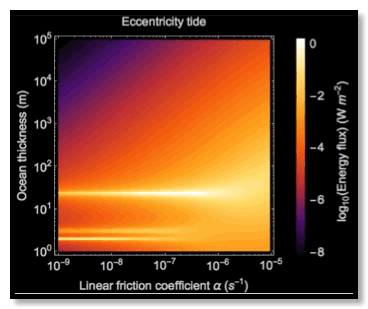Tidal heating in the oceans of icy satellites
22/07/21 14:20

There is a pressing need for the community to develop models of ocean tidal heating that take into account the effect of a solid lid on ocean dynamics. This is important for Enceladus, Titan, Europa, Ganymede and Callisto given that each of them is likely characterized by a ∼10 − 100 km thick solid shell overlying an ocean layer. An additional topic not yet addressed within the icy satellite community is how a non-global or variable thickness subsurface ocean would affect tidal heating. Enceladus likely falls into this category since extensive resurfacing is limited to its South Polar Terrain, which is also characterized by a large thermal anomaly. Tidal heating is thought to be the main source of this heat signature. NASA’s Cassini spacecraft obtained measurements of this surface heat flux, and these data can, in principle, be used to constrain ocean thickness. However, in order to explore this connection, it is necessary to consider heating in a variable thickness subsurface ocean, a task that can only be performed numerically. I am currently supervising a graduate student (Hamish Hay) to work on this ambitious problem.
Relevant publications:
- Downey, B. G., Nimmo, F. & Matsuyama, I. Inclination damping on Callisto. Monthly Notices of the Royal Astronomical Society 499, 40–51 (2020).
- Hay, H., Trinh, A. & Matsuyama, I. Powering the Galilean Satellites with Moon‐moon Tides. Geophys. Res. Lett. 47, (2020).
- Hay, H. C. F. C. & Matsuyama, I. Tides Between the TRAPPIST-1 Planets. The Astrophysical Journal 875, 22 (2019).
- Hay, H. C. F. C. & Matsuyama, I. Nonlinear tidal dissipation in the subsurface oceans of Enceladus and other icy satellites. Icarus 319, 68–85 (2019).
- Matsuyama, I., Beuthe, M., Hay, H. C. F. C., Nimmo, F. & Kamata, S. Ocean tidal heating in icy satellites with solid shells. Icarus 312, 208–230 (2018).
- Hay, H. C. F. C. & Matsuyama, I. Numerically modelling tidal dissipation with bottom drag in the oceans of Titan and Enceladus. Icarus 281, 342–356 (2017).
- Matsuyama, I. Tidal dissipation in the oceans of icy satellites. Icarus 242, 11–18 (2014).
